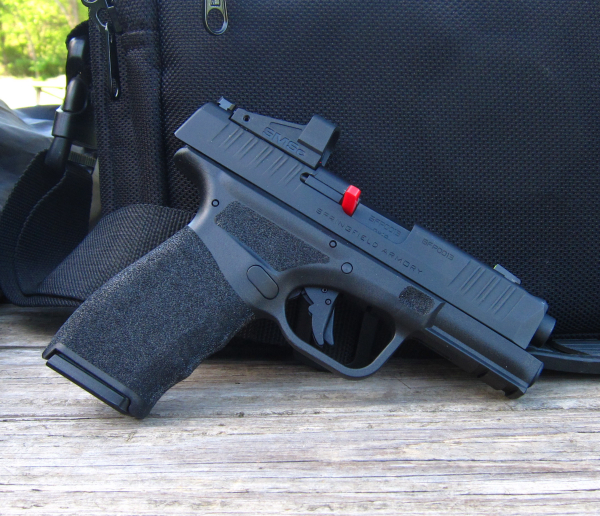
Overnight, Springfield Armory released the latest version of the Hellcat Pro pistol, the Hellcat Pro Comp. The 3.7” hammer forged steel/Melonite treated barrel is interrupted by a “compensator” cut at 12 o’clock near the muzzle. The slide is likewise cut to allow burning gasses to vent, reducing (to some extent) recoil – and projectile velocity.
The single-port comp vents gas up to reduce muzzle flip. The front sight – part of the superb Springfield Armory tritium-luminescent front and “Tactical Rack” U-notch rear sights – is located behind the comp.
Before anyone cries over “lost” sight radius, check your bullseye scores on slowfire at 25 yards. If you regularly shoot 100 for a pair of five round strings, one-handed, then we can discuss the “lost” bit of sight radius. Until then, you won’t notice it anyway.
The sample arrived prefitted with the Shield Mini Sight Compact (SMSc) pistol mounted optic. I’ve used these before with some success. Sitting low as it does on the HCP-c, I can still readily see the factory irons.
I’ve had the gun a few months, but, as the release date was some distance away, I put in time on other projects. A few range trips over April and May had the optic zeroed, velocity comparison done with an un-comped HCP, accuracy testing and then just shooting some drills to try to determine the difference between the more-or-less standard Hellcat Pro and the Comp version.
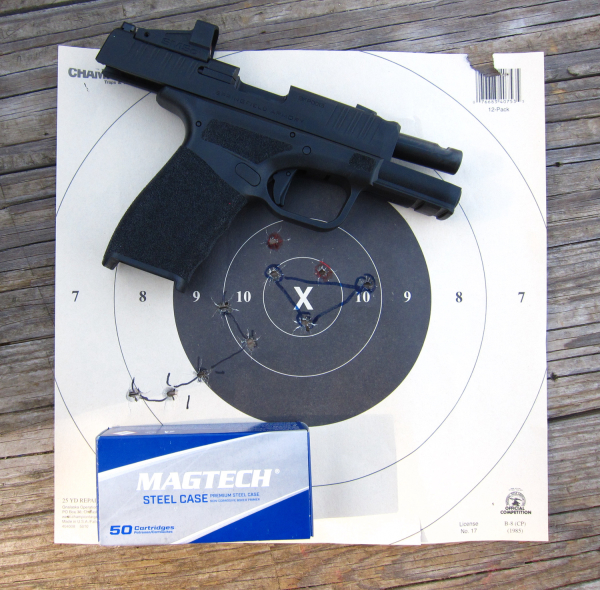
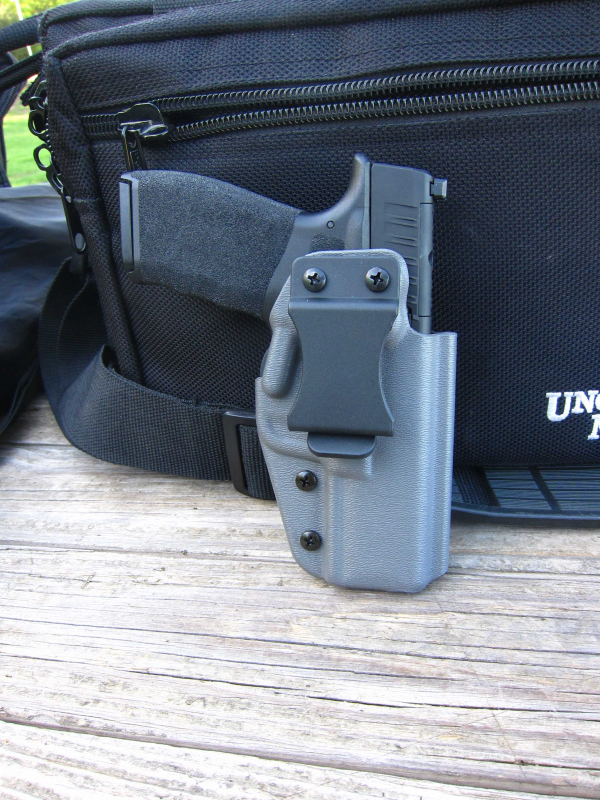
First, I have to say that the Hellcat Pro is a nicely appointed “not-quite-micro-“ 9mm pistol. With a fifteen-round cargo hold (in “free” states) and the slightly-longer-than-Hellcat barrel, slide and frame, it shoots like a service pistol – though a bit slower.
The lighter-than-Echelon slide should theoretically kick less than the service pistol, but reciprocating slide mass doesn’t have quite the impact of total weight of the gun when “feeling” recoil. Neither are a chore, but the service pistol is something easy to shoot for hours at a time, until you get bored. The “micro” pistols tend to induce some fatigue, in my experience. They are also harder to shoot well, according to many.
I’m getting more experience with these small guns than I wanted – at the outset. But the utility is so great, I find the effort rewarding.
There are three iterations of the Hellcat Pro Comp currently available. The gun I got came with a fifteen-round flush fit magazine and a 17-round extended magazine. With guns this size, I have no problem with downloading magazines by 1- or two rounds to make an in-battery load a little easier.
An option is to get the gun with a pair of 15 round magazines (like the original Hellcat Pro sample) or to get the gun with politically-required 10-round magazines; the MSRP for any of the variations is set at $699. Like the previous Hellcat Pros, this gun is (obviously) optics ready and has the obligatory accessory railed dust cover.
The gun ships with a double-zipper soft case.
The initial zero with Magtech 115gr. FMJ Steel Case from 16 yards was accomplished in ten rounds. The first group clustered low left with some vertical stringing. The ‘by guess’ adjustments put the next pair at 12 o’clock. The last three snugged into just over an inch centered over the bull.
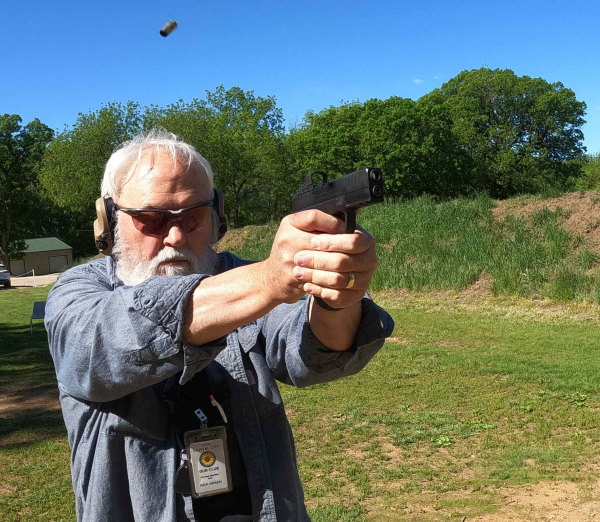
The next trip saw me shooting over a range bag at 25 yards, using the Garmin Xero Pro C1 chronograph. I compared velocity with an earlier issue Hellcat Pro – that only had the factory iron sights. I put all hits on target to compare (unfairly) accuracy.
The Hornady Critical Duty 135gr FTX round just broke 1,000 fps (average 1,004) out of the comped gun, with five hits going into 3 ½”. This isn’t bad, but the best three of five – something that’s more predictive of shooting the gun from a mechanical rest – clustered into 1 ¾”. The standard Hellcat Pro put the Hornady round out at an average 1,020 fps, with five rounds into four inches. The “best three” shot inside two inches.
Speer 124 grain Gold Dot HP blasted out of the HCPc at 1,113 fps and gave a group of 3”. The standard gun yielded 1,135fps average.
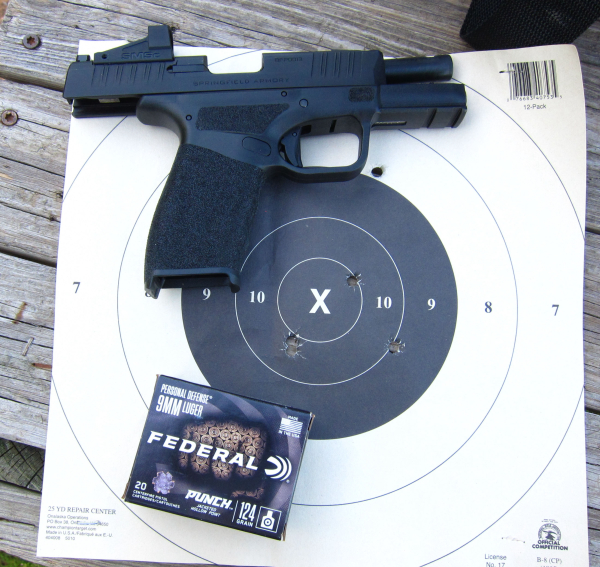
In the right hands, the Hellcat Pro Comp with an optic is easily a three-inches at 25 yards gun.
Shooting one gun after the other off the bench, the difference in felt recoil is remarkable. It’s not a huge amount, but the recoil felt more “solid” in the un-comped gun.
On the next range trip, I used a DeSantis Gunhide holster, the new #220 “Mean Streak.” Big holster makers are paying attention to user feedback and that can most clearly be seen in the new thermoformed polymer holsters. Adjustable for height and cant, I used it as it fell from the bag. The integral sweat guard keeps the body off the gun and the holster body has a pre-formed extension at the base of the trigger guard. When the belt is against it, it moves the grip of the gun into the body, enhancing concealment.
The holster’s edges are polished. Fortunately, the Mean Streak is made for guns with installed optics; no fit issues there. MSRP is set at $59.99.
I did some work on B-8 repair centers from 20 feet to get a feel for the gun. I proved to myself that I’m still not an optics-type. Still, the only time I didn’t immediately see the dot, the front sight was hovering over the “X” so it didn’t matter.
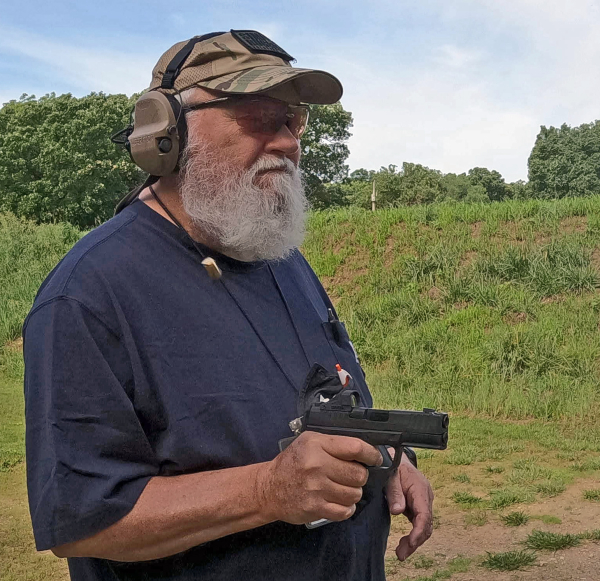
I shot some ICE-qualification style “bent-elbow” close quarters shooting – still on a B-8 repair center, all from the holster. The drill is draw to a single, followed by a draw to a pair and finishing with a draw to three hits. I was preparing for the concern that hot gas erupting from the comp cut would injure the shooter or create some kind of issue – needlessly, as it turned out. One hit was outside the “10,” in the 9-ring of the repair center.
I finished up with the “trade-mark drill,” working around the outside perimeter of the repair center on bar-code, trademarks and other small, identifying printed information.
Like the original Hellcat Pro, the HCPc has been reliable, accurate, pleasant to shoot – it’s handy to carry too. That’s something I found out as a suddenly required errand saw me armed with the T&E gun.
I didn’t give it a second thought; I knew the gun would work just fine.
— Rich Grassi
SPECIFICATIONS
Caliber: 9mm
Color: Black
Barrel: 3.7" Hammer Forged Steel, Melonite® Finish, 1:10
Slide: Billet Machined, Melonite® Finish, Optics Ready, Integral Compensator
Frame: Black Polymer w/ Adaptive Grip Texture
Sights: Tritium/Luminescent Front, Tactical Rack U-Notch Rear
Recoil System: Dual Captive Recoil Spring w/ Full Length Guide Rod
Grip Width: 1"
Magazines: (1) 15-Round, (1) 17-Round
Weight: 21 oz w/ Flush Mag, 21.4 oz w/ Extended Mag
Length: 6.6"
Height: 4.8" w/ Flush Mag, 5.3" w/ Extended Mag
MSRP: $699